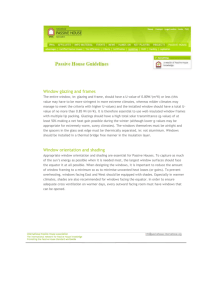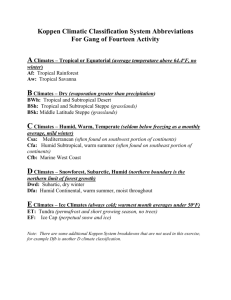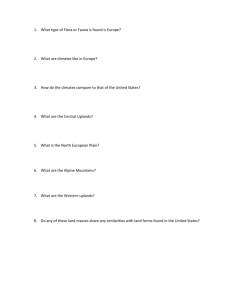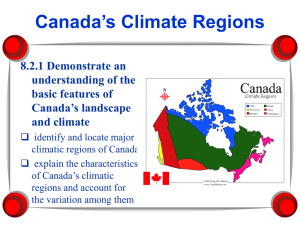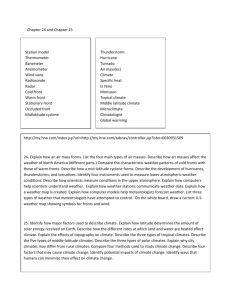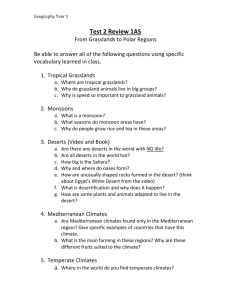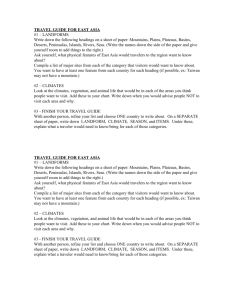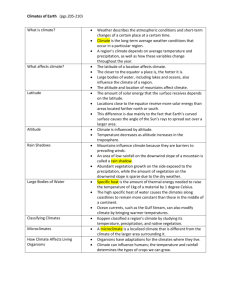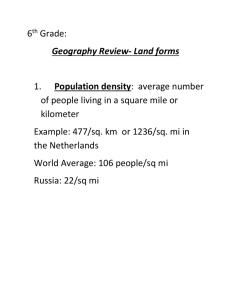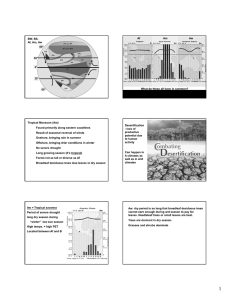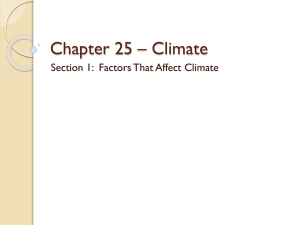climatelesson - tch347fall0904colleen
advertisement
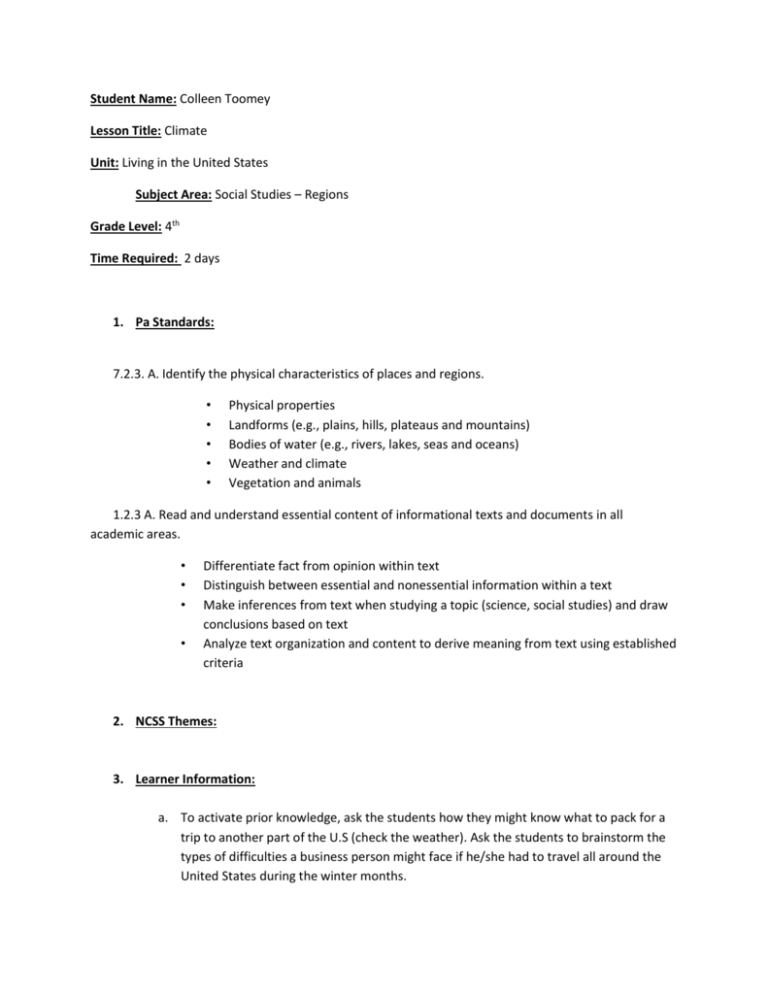
Student Name: Colleen Toomey Lesson Title: Climate Unit: Living in the United States Subject Area: Social Studies – Regions Grade Level: 4th Time Required: 2 days 1. Pa Standards: 7.2.3. A. Identify the physical characteristics of places and regions. • • • • • Physical properties Landforms (e.g., plains, hills, plateaus and mountains) Bodies of water (e.g., rivers, lakes, seas and oceans) Weather and climate Vegetation and animals 1.2.3 A. Read and understand essential content of informational texts and documents in all academic areas. • • • • Differentiate fact from opinion within text Distinguish between essential and nonessential information within a text Make inferences from text when studying a topic (science, social studies) and draw conclusions based on text Analyze text organization and content to derive meaning from text using established criteria 2. NCSS Themes: 3. Learner Information: a. To activate prior knowledge, ask the students how they might know what to pack for a trip to another part of the U.S (check the weather). Ask the students to brainstorm the types of difficulties a business person might face if he/she had to travel all around the United States during the winter months. b. Depending on the learning diversity of my classroom I would modify steps to better help the needs of my students. These next 3 activities can help ELL and special need students as well as other cultural diversities to better help the students relate climate concepts to places which they are familiar. i. Beginning1. Create flashcards with key terms from this lesson such as humid, wet, dry, warm, cold, high, low, near, water, and far. Have the students choose flashcards that describe their current community. ii. Intermediate1. Have the students read a weather forecast in an almanac and compare it to a typical televised or newspaper weather report. Ask the students in what instances might each forecast or report be more useful. 2. Have the students use key terms from this lesson to state one or two facts about the climate of a different country. iii. Advanced1. Have the students examine a weather map in a newspaper, analyze its symbols and key, and explain to the class how to read it. 2. Have students create two column chart labeled Community and Climate. Then have them fill in the chart with details about the climate in their current community and two other communities. c. These types of broken down activities can help assist learner diversity. 4. Learning Objectives: a. Explain the difference between weather and climate b. Describe the climate of each region in the United States c. Describe the 3 main factors that affect the climate of an area d. Describe the major types of climates around the world 5. Materials: a. Workbooks, transparency, learning guides, quick study 6. Procedures: a. Read the following sections as a class (weather and climate, water in the air, what causes climate?, types of climates) b. Ask questions: i. Summarize the main difference between weather and climate 1. Weather refers to the conditions at a certain time and place and climate is the average weather of a place over a longer period of time. ii. Why would a farmer need to know about the climate of an area? 1. To know what crops to plan and when to plant them. iii. Besides cold and warm, what other words do people often use to describe the weather? iv. v. vi. vii. viii. ix. x. xi. 1. Freezing, chilly, brisk, pleasant, hot, steamy, broiling What makes water vapor in the air form into small drops? 1. Cooling of the air What happens in clouds before rain or snow can fall? 1. Tiny drops of water join together and form big clouds. What parts of the earth have the coldest climate? 1. The places that are the farthest from the equator such as the North Pole and the South Pole. Boston and Worcester, Massachusetts, are about the same distance from the equator, but Boston is on the Atlantic Ocean, while Worcester is about 40 miles inland. Which city do you think will be warmer in summer? Colder in winter? 1. Worcester; Worcester Is it possible to find snow on a very tall mountain near the equator? Why or why not? 1. Yes, because the temperature is lower the higher you go above sea level. If subtropical climates are near tropical climates and subarctic climates are near polar climates, what might be another name for polar climate? 1. An arctic climate How might you describe a polar climate? 1. It is cold most of the year. The ground is covered with snow most of the year. What five types of climates can be found in the United States? 1. Tropical, subtropical, temperate, subarctic, and polar. Curriculum integration: Science- Explore Meteorology o Tell students that many professional weather forecasters are trained meteorologists. o Have the students research the definitions of meteorology (the study of weather) and climatology (the study of climates). o Ask the students to write a paragraph comparing and contrasting these two fields of science. Writing- Celebrate Climate o Have the students write a poem about the climate of your region or some other region they have lived in or visited. o Direct the students to devote a stanza to each weather pattern they want to describe. o Encourage students to include facts in each stanza of their poem. Math – Comparing Climate temperatures o Have the students add, subtract, and multiply different temperatures in Fahrenheit. 7. Assessment: a. Have the students take turns reading the four main points. Ask the students to turn each statement into a question and answer each questions with their book closed. i. Four main points: 1. On a separate sheet of paper, make a diagram like the one shown. Fill in some details of each type of climate. (answers are in red, they will vary) The world has four major climates. A temperate climate is moderate A polar climate is the coldest. A tropical climate is warm all year A subarctic climate has warm periods. 2. Write a sentence describing the difference between weather and climate. 3. Describe the variations in climate in each region of the United States. 4. What are the three main factors that affect climate? Due to the fact that there will probably be many ELL and special needs children in the classroom, I will allow the students to work with a partner. For the students that need the extra help, I will chose who they will work with. It’s important to chose a student who is patience and helpful when selecting them to work with others.

